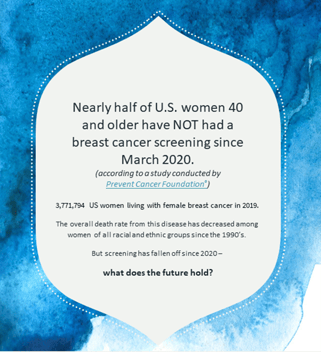This interactive portal improves the analytic experience so you can easily interact with data.
Breast Cancer Costs Everyone

.jpg?width=120&name=Carole%20(2).jpg)
Carole Bonner
COVID-19 brought with it a reluctance to get routine, potentially lifesaving cancer screenings, however it is time to get back on track.
A 2021 survey conducted by the Prevent Cancer Foundation® reveals nearly half of U.S. women who are 40 and older had NOT had a breast cancer screening since March 2020. Now that vaccines and boosters are relatively easy to access and there are no longer restrictions in movement, 90% of the women surveyed say they have resumed normal activities like shopping and dining out. Alarmingly, less than half of women have visited the doctor.
who are 40 and older had NOT had a breast cancer screening since March 2020. Now that vaccines and boosters are relatively easy to access and there are no longer restrictions in movement, 90% of the women surveyed say they have resumed normal activities like shopping and dining out. Alarmingly, less than half of women have visited the doctor.
- Approximately 13% of women will be diagnosed with breast cancer in their lifetime
- Female breast cancer represents 15% of all new cancer cases in the US in 2022.
- The 5-year relative survival is 90.6%.
The rate of new cases has increased slightly since the late 1990’s, however the death rate has significantly decreased. This is partly attributed to early detection that can be achieved through regular screenings and to advances in treatment.
Female breast cancer is the fourth leading cause of cancer death in the United States and the second most common cause of cancer deaths among adult women. The death rates vary considerably by age, racial, and ethnic group. The American Cancer Society recommends that with average risk:
- Women ages 40 to 44 can choose to start breast cancer screening with annual mammograms
- Women aged 45 to 54 should get annual mammograms.
- Women 55 and older should switch to mammograms every 2 years or can continue yearly screening.
All women should be made aware of the benefits of breast cancer screening. Employers should also be mindful of the advantages of their employee population’s adherence to preventative screening guidelines.
Breast Cancer costs employers: here are some facts to consider
A 2020 study estimated productivity costs due to metastatic breast cancer using publicly available data. In the adjusted analysis of work and home productivity days lost, women ages 18 – 64 who were within 2 years of their breast cancer diagnosis lost from 6 to 10 times the number of days compared with similar women without a history of breast cancer. Women ages 18 – 64 lose an average of 31.4 lost workdays and 26 lost home productivity days. In 2022, 287,850 new cases of invasive and 51,400 new cases of non-invasive breast cancer were reported among women in the U.S.
According to Northeast Business Group on Health (NEBGH), employers report a level of complexity in managing employees’ cancer-related needs because of the related costs. In the United States, cancer treatment makes up 12% of employers’ total medical costs. According to a report by John Hopkins this amounts to $125 billion spent on direct medical costs and another $139 billion in productivity losses and lost work time. Cancer caregivers often suffer stress-related illnesses which impacts their work productivity.
What can employers do to engage and support employees and managers?
It is important for employers to be prepared to support most employees who want or need to keep working throughout their treatment. Employers benefit from having their experiences employees remain and to be as productive as possible on the job. Treatments for breast cancer have continued to improve over time. They now have fewer side effects and are less impactful to the patients’ quality of life. Here is how to employers can maximize productivity and minimize losses.
- Open the lines of communication between the employee and leadership. It is important for managers to be aware that there are fluctuations in the aftereffects of treatments and the employee may or may not be able to work.
- Educate and inform employees and managers of company policy regarding work flexibility and sick leave.
- While only 34% of worksites that have WHPs, offer health education programs, health education is an important part of a comprehensive benefit plan. It is beneficial across all sectors, demographics, and health statuses. Education is integral to empower employees to take charge of their health. This can be sending email blasts, distributing brochures, monthly health focuses, classes, or one-on-one coaching. Include breast cancer education in that plan.
- Managers need readily available and current information when they learn that they have an employee who is dealing with a cancer diagnosis or caring for someone with cancer.
There are helpful resources for employers and employees on the complex topic of cancer. You can begin here Breast Cancer Resources | LBBC and here Breast Cancer Foundation | Susan G. Komen®.
“An ounce of prevention is worth a pound of cure.” -Benjamin Franklin
Finally, but most importantly, it is estimated that 42% of cancers can be prevented by managing risk factors. According to Johns Hopkins, routine screening help to pre-diagnose/prevent some cancers. In addition to healthy lifestyle choices such as eating right and staying physically active.
Promote appropriate cancer screenings!
Generally, one-time projects will not likely have a lasting effect on cancer screening rates in your organization. However, after countless delayed screenings during the pandemic, it may be highly beneficial to be intentional about promoting health and preventing breast cancer through an aggressive project.
Start here for more resources, and don’t let it stop there. Develop a holistic approach beginning with open talks and encouraging prevention and early detection through screenings.
- February 2025 (1)
- December 2024 (2)
- March 2024 (1)
- January 2024 (1)
- October 2023 (3)
- September 2023 (1)
- July 2023 (1)
- May 2023 (1)
- April 2023 (1)
- February 2023 (1)
- January 2023 (1)
- December 2022 (1)
- November 2022 (1)
- October 2022 (1)
- September 2022 (1)
- August 2022 (2)
- July 2022 (1)
- June 2022 (3)
- May 2022 (2)
- April 2022 (1)
- March 2022 (2)
- February 2022 (1)
- January 2022 (1)
- December 2021 (1)
- November 2021 (1)
- October 2021 (1)
- August 2021 (1)
- July 2021 (2)
- June 2021 (1)
- May 2021 (1)
- April 2021 (1)
- February 2021 (1)
- January 2021 (3)
- August 2020 (1)
- July 2020 (3)
- May 2020 (1)
- April 2020 (4)
- March 2020 (4)
- February 2020 (1)
- January 2020 (1)
- November 2019 (2)
- July 2019 (4)
- June 2019 (3)
- May 2019 (2)
- April 2019 (2)
- March 2019 (3)
- February 2019 (7)
- January 2019 (9)
- November 2018 (6)
- October 2018 (3)
- September 2018 (3)
- August 2018 (2)
- July 2018 (4)
- March 2018 (22)
- February 2018 (1)
- October 2017 (1)
- September 2017 (1)
- August 2017 (1)
- July 2017 (1)
- June 2017 (3)
- May 2017 (2)
- April 2017 (1)
- March 2017 (29)
- February 2017 (1)
- January 2017 (1)
- December 2016 (3)
- November 2016 (2)
- October 2016 (1)
- August 2016 (3)
- May 2016 (2)
- April 2016 (8)
- February 2016 (29)
- January 2016 (1)
- December 2015 (2)
- July 2015 (4)
- June 2015 (6)
- May 2015 (1)
- April 2015 (1)
- March 2015 (22)
- February 2015 (1)
- January 2015 (1)
- December 2014 (1)
- November 2014 (1)
- October 2014 (2)
- September 2014 (1)
- August 2014 (3)
- July 2014 (2)
- June 2014 (1)
- May 2014 (2)
- April 2014 (4)
- March 2014 (8)
- February 2014 (1)
- January 2014 (1)
- December 2013 (2)
- November 2013 (2)
- October 2013 (4)
- August 2013 (1)
- July 2013 (3)
- May 2013 (13)
- March 2013 (2)
- February 2013 (9)
- January 2013 (1)
- December 2012 (1)
- November 2012 (1)
- June 2012 (1)
- May 2012 (1)
- April 2012 (1)
- August 2011 (1)
- June 2011 (3)
- May 2011 (1)
- April 2011 (2)
- March 2011 (1)
- February 2011 (2)
- November 2010 (1)
- October 2010 (1)
- June 2010 (1)
- March 2010 (1)
- January 2010 (2)
- October 2009 (1)
- July 2009 (1)
- May 2009 (2)
- March 2009 (1)
- January 2009 (1)
- November 2008 (1)
- October 2008 (2)
- September 2008 (1)
- August 2008 (1)
- June 2008 (1)
- May 2008 (1)
- April 2008 (2)
- March 2008 (1)
- February 2008 (1)
- January 2008 (2)
- December 2007 (1)
- November 2007 (1)
- October 2007 (1)
- September 2007 (1)
- August 2007 (1)
- July 2007 (1)
- June 2007 (1)
- May 2007 (2)
- March 2007 (1)
- February 2007 (1)
- January 2007 (1)
- August 2006 (1)
- June 2006 (1)
- March 2006 (1)
- May 2005 (1)
- July 2004 (1)
- 2019 (1)
- 2020 (1)
- Absence (2)
- Absence Management (4)
- Article (105)
- Behavioral Health (2)
- Benchmarking (9)
- Benefit Design (11)
- Benefits + Plan Design (26)
- Blog (72)
- Burnout (1)
- Business Performance (2)
- Business Value of Health (21)
- Cancer (3)
- Cardiovascular Disease (4)
- Care Management (1)
- Care Quality (1)
- Caregiving (3)
- Case Studies (7)
- Chronic Conditions (2)
- Communicating H&P to Business Leaders (1)
- Community Health (2)
- Comparative Effectiveness Research (1)
- Connecting HR to Operations (1)
- COVID-19 (13)
- Culture of Health (1)
- Culture of Health + Safety (29)
- Data (1)
- Data Driven Decision Making (1)
- Depression (5)
- Diabetes (5)
- Disability Leave (41)
- Disease Burden (1)
- Employer Perspectives (5)
- Engage Employees (45)
- Event Recap (2)
- Exchanges (4)
- Family + Parental Leave (8)
- FMLA (2)
- Headache (1)
- Health + Productivity Management (54)
- Health Inequities (1)
- Healthcare (2)
- Healthcare Costs (17)
- HPM Survey (3)
- IBI Agenda (2)
- IBI Presents (9)
- immunization (1)
- Industry Profile (1)
- Integrating Health Data (12)
- Invest In Health (52)
- Leave Benchmark Survey (1)
- Linking Health to Business Performance (1)
- Make The Business Case (54)
- Manage Absence (70)
- Market Perspectives (29)
- Maternity (1)
- Measurement (2)
- Measuring Outcomes (21)
- Medication Adherence (1)
- Mental + Emotional Health (16)
- Mental Health (7)
- Migraine (2)
- MSD (1)
- MSK (1)
- Multi-Study Spotlight (23)
- Musc (1)
- Musculoskeletal Disorders (12)
- National Forum (1)
- Obesity (2)
- Occupation (1)
- Online Events (17)
- Pain Management (1)
- Patient Resources (1)
- Patient-Centered (2)
- Pharmacy (5)
- Physical Activity (1)
- Popular and Timely (11)
- Practical Guidance (6)
- Pregnancy (1)
- Presenteeism (1)
- Presenteeism / Job Performance (3)
- Preventive Care (1)
- Previous Forums (109)
- Productivity (46)
- Provider Quality (1)
- Regional Events (1)
- Research (22)
- Research Based Healthcare Evidence (1)
- Research Report (2)
- Research Review (3)
- Return to Work (19)
- Risk Management (11)
- SAW / RTW (1)
- Scholarly Work (2)
- Short-Term Disability (2)
- Sick Leave (15)
- Social Determinants of Health (1)
- Stay at Work (1)
- Stay-at-work / Return-to-work (1)
- STD (2)
- Strategies (1)
- Stress (2)
- Suicide (2)
- Surveys (3)
- Talking to Leadership (4)
- Telehealth (3)
- Understand Health Risks (34)
- Value-based Benefit Design (1)
- Vendor Integration (1)
- Video (3)
- virtual care (1)
- virtual health (1)
- Weight Control (5)
- Well-being (16)
- Wellness + Lifestyle (17)
- Working Remotely (4)
- Workplace Culture of Health (2)
- Workplace Health Programs (1)
- Admin
- Brian Gifford
- Brian Gifford Ph.D. Director, Research and Analytics, IBI
- Candace Nelson
- Carole Bonner
- Carolyn Ho
- Carolyn Ho, IBI Communications Lead
- Erin Peterson
- Erin Peterson, Researcher
- Gia Harris
- IBI
- IBI Member
- IBI Research Team
- Integrated Benefits Institute
- Jennifer Santisi
- Jim Huffman
- Kelly McDevitt, IBI President
- Marshall Riddle
- Nicole Nicksic, PhD, MPH Research Lead
- Sera-Leigh Ghouralal
- Thomas Parry, PhD Senior Advisor, Integrated Benefits Institute






















.png?width=900&name=Copy%20of%202024%20Research%20Priorities%20Banner(5).png)

